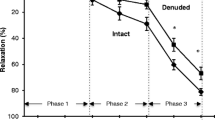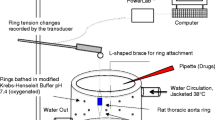Summary
Nicorandil is an antianginal vasodilator having a hybrid property between nitrates and potassium channel openers, and cromakalim is a relatively specific potassium channel opener. We investigated whether or not the vasorelaxant actions of the two drugs would be selective for certain vasoconstrictor agonists (simplyagonists hereafter), and the underlying mechanisms in isolated porcine large coronary arteries. Both nicorandil and cromakalim produced a complete relaxation in the arteries precontracted with seven agonists, i.e., Bay-K-8644, endothelin, histamine, 5-hydroxy-tryptamine (5-HT), phenylephrine, PGF2α, and U 46619. The EC50 values (−log M) of nicorandil and cromakalim were 5.20–5.44 and 6.43–6.87, respectively, toward the seven agonists, indicating that the vasorelaxant actions of the two drugs were agonist nonselective. In the arteries precontracted with Bay-K-8644, endothelin, 5-HT, and U 46619, the vasorelaxant action of cromakalim was antagonized by glibenclamide, an antagonist of potassium channel openers, and Schild analysis of these antagonisms yielded pA2 values of 7.10–7.41 for glibenclamide. The vasorelaxant actions of nicorandil in the arteries precontracted with the four agonists each were not antagonized by glibenclamide. Instead, the vasorelaxant action of nicorandil was antagonized by methylene blue (10 µM), an inhibitor of guanylate cyclase, and slightly potentiated by M&B 22,948 (10 µM), an inhibitor of cyclic-GMP phosphodiesterase, in the arteries precontracted with U 46619. These results indicate that the vasorelaxant actions of nicorandil and cromakalim in the porcine large coronary artery are agonist nonselective and that nicorandil exerts such an action entirely as a nitrate, whereas cromakalim does so entirely as a potassium channel opener.
Similar content being viewed by others
References
Dhurandhar RW, Watt DL, Silver MD, et al. Prinzmetal's variant form of angina with ateriographic evidence of coronary arterial spasm.Am J Cardiol 1972;30:902–905.
Oliva PB, Potts DE, Pluss RG. Coronary arterial spasm in Prinzmetal angina. Documentation by coronary angiography.N Engl J Med 1973;288:745–751.
Meller J, Pichard A, Dack S. Coronary arterial spasm in Prinzmetal's angina: A proved hypothesis.Am J Cardiol 1976;37:938–940.
Specchia G, de Servi S, Falcone C, et al. Coronary arterial spasm as a cause of exercise-induced ST-segment elevation in patients with variant angina.Circulation 1979;59:948–954.
Yasue H, Omote S, Takizawa A, et al. Exertional angina pectoris caused by coronary arterial spasm: Effects of various drugs.Am J Cardiol 1979;43:647–652.
Yasue H. Pathophysiology and treatment of coronary arterial spasm.Chest 1980;78:216S-223S.
Shepherd JT, Vanhoutte PM. Spasm of the coronary arteries: Causes and consequences (the scientist's viewpoint).Mayo Clin Proc 1985;60:33–46.
Godfraind T, Miller R, Wibo M. Calcium antagonism and calcium entry blockade.Pharmacol Rev 1986;38:321–416.
Fleckenstein A.Calcium Antagonism in Heart and Smooth Muscle. New York: John Wiley & Sons, 1983.
Angus JA, Brazenor RM. Relaxation of large coronary artery by verapamil, D600, and nifedipine is constrictor selective: Comparison with glyceryl trinitrate.J Cardiovasc Pharmacol 1983;5:321–328.
Kinoshita M, Nishikawa S, Sawamura M, et al. Comparative efficacy of high-dose versus low-dose nicorandil therapy for chronic stable angina pectoris.Am J Cardiol 1986;58:733–738.
Hayata N, Araki H, Nakamura M. Effects of nicorandil on exercise tolerance in patients with stable effort angina: A double-blind study.Am Heart J 1986;112:1245–1250.
Kishida H, Murao S. Effect of a new coronary vasodilator, nicorandil, on variant angina pectoris.Clin Pharmacol Ther 1987;42:166–173.
Aizawa T, Ogasawara K, Kato K. Effects of nicorandil on coronary circulation in patients with ischemic heart disease: Comparison with nitroglycerin.J Cardiovasc Pharmacol 1987;10(Suppl 8):S123-S129.
Taira N. Similarity and dissimilarity in the mode and mechanism of action between nicorandil and classical nitrates: An overview.J Cardiovasc Pharmacol 1987;10(Suppl 8):S1-S9.
Taira N. Nicorandil as a hybrid between nitrates and potassium channel activators.Am J Cardiol 1989;63:18J-24J.
Satoh K, Yamada H, Taira N. Differential antagonism by glibenclamide of the relevant effects of cromakalim, pinacidil and nicorandil on canine large coronary arteries.Naunyn Schmiedebergs Arch Pharmacol 1991;343:76–82.
Satoh K, Yamada H, Yoneyama F, Taira N. The group at C2 of N-ethylnicotinamide determines the vasodilator potencies and mechanisms of action of nicorandil and its congeners in canine coronary arteries.Naunyn Schmiedebergs Arch Pharmacol 1991;344:589–595.
Weir SW, Weston AH. The effects of BRL 34915 and nicorandil on electrical and mechanical activity and on86Rb efflux in rat blood vessels.Br J Pharmacol 1986;88:121–128.
Weston AH, Abbott A. New class of antihypertensive acts by opening K+ channels.Trends Pharmacol Sci 1987;8:283–284.
Cavero I, Mondot S, Mestre M. Vasorelaxant effects of cromakalim in rats are mediated by glibenclamide-sensitive potassium channels.J Pharmacol Exp Ther 1989;248:1261–1268.
Gruetter CA, Kadowitz PJ, Ignarro LJ. Methylene blue inhibits coronary arterial relaxation and guanylate cyclase activation by nitroglycerin, sodium nitrite and amyl nitrite.Can J Physiol Pharmacol 1981;59:150–156.
Kukovetz WR, Holzmann S, Wurm A, Pöch G. Evidence for cyclic GMP-mediated relaxant effects of nitro-compounds in coronary smooth muscle.Naunyn Schmiedebergs Arch Pharmacol 1979;310:129–138.
Parker RB, Waud DR. Pharmacological estimation of drug-receptor dissociation constants. Statistical evaluation. I. Agonists.J Pharmacol Exp Ther 1971;177:1–12.
Arunlakshana O, Schild HO. Some quantitative uses of drug antagonists.Br J Pharmacol 1959;14:48–58.
Dunnett CW. New tables for multiple comparisons with a control.Biometrics 1964;20:482–491.
Snedecor GW, Cochran WG.Statistical Methods, 6th ed. Ames, IA: The Iowa State University Press, 1967.
Author information
Authors and Affiliations
Rights and permissions
About this article
Cite this article
Satoh, K., Mori, T., Yamada, H. et al. Nicorandil as a nitrate, and cromakalim as a potassium channel opener, dilate isolated porcine large coronary arteries in an agonist-nonselective manner. Cardiovasc Drug Ther 7, 691–699 (1993). https://doi.org/10.1007/BF00877823
Received:
Accepted:
Issue Date:
DOI: https://doi.org/10.1007/BF00877823




